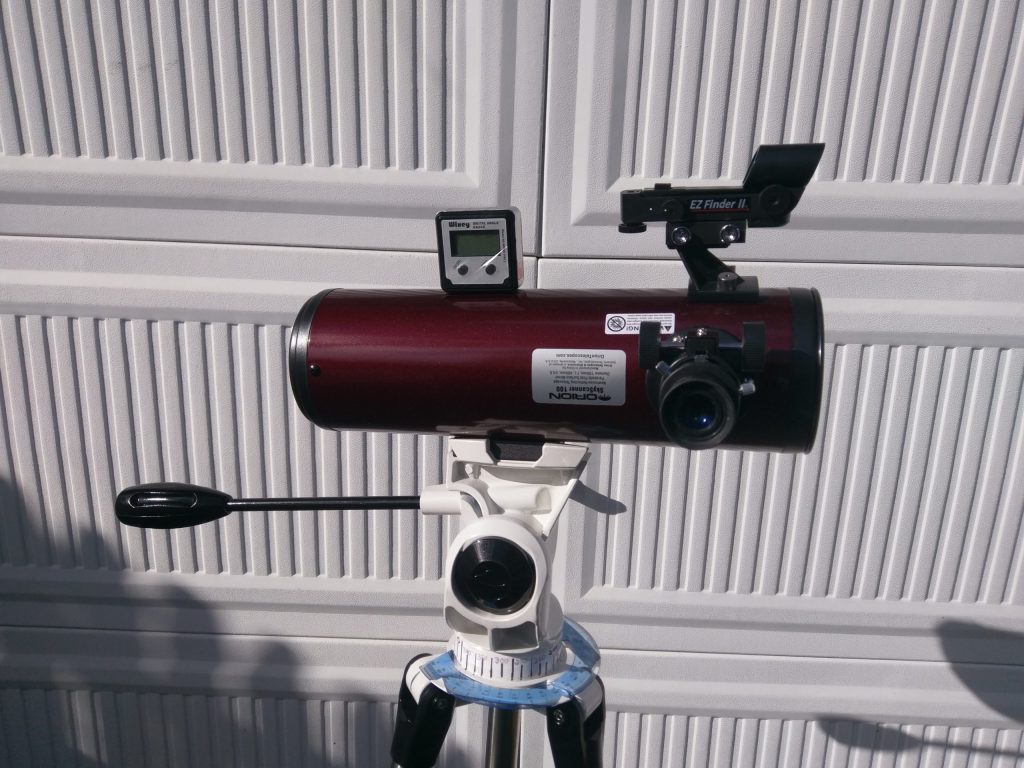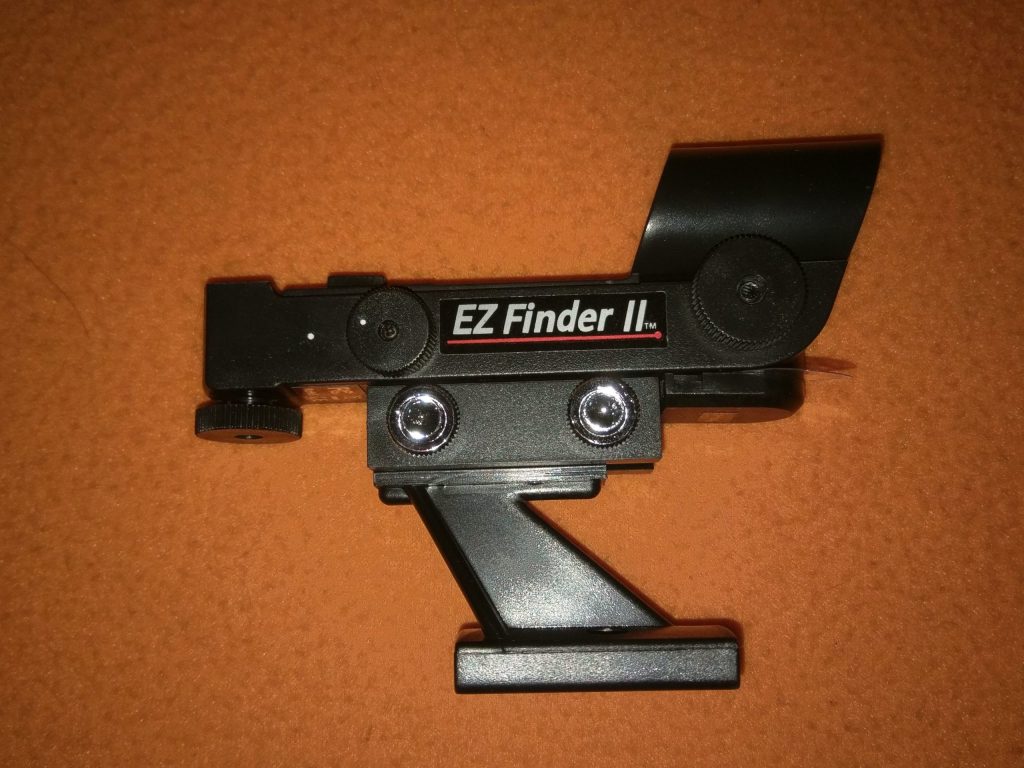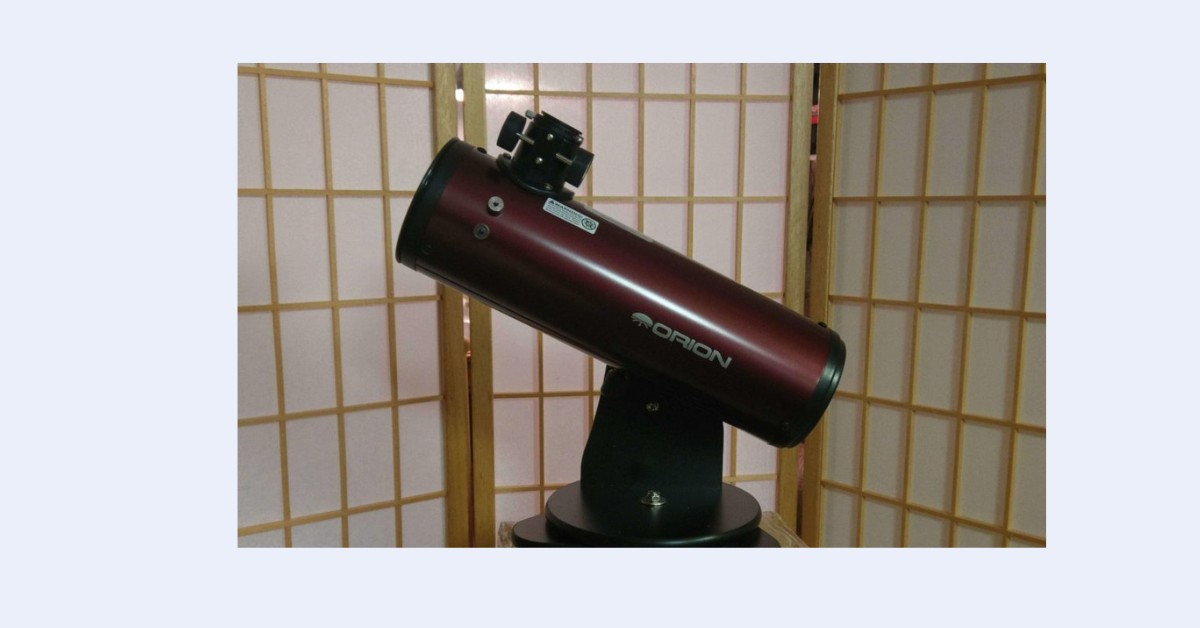The Fixed Primary Mirror
Normally, a Newtonian reflector telescope has a way to adjust the primary mirror to get the optics aligned in a process called collimation, and the primary mirror would normally have a center spot as an alignment target for this collimation process.
The SkyScanner 100 does not have provisions for adjusting the primary mirror, and the mirror is not center-spotted. It is collimated at the factory and fixed in place. This can present problems if the scope is knocked out of collimation during use/shipping, but there are methods (although not exactly easy) that allow one to collimate the primary mirror. But from what I know, the scope tends to hold collimation well over the years.
The secondary mirror can be adjusted for collimation, though this should rarely, if ever, be needed.
I checked my scope’s collimation and it appeared to be on the money. A defocused star test also showed that the scope was properly collimated. As there is no center spot on the primary mirror, there was no reference point to make a precise confirmation, but it looked good to me.
The Focuser
The focuser is a standard 1.25” rack and pinion unit. While plastic, it works surprisingly well even at relatively high magnifications. It was quite stiff when I first used it. Now that I have had it out a few times, it seems to be loosening up a bit.
Mounting the Optical Tube
The intention is that you place this on a table, stool, or some other suitable stand so it is at a comfortable height. It is light enough that even a sturdy box could serve as a base. Just make sure that it is rock solid and steady. I have seen reports of people using it on the hood of their car or placed on a large rock when camping. Just remember that, if the base moves, the image in the eyepiece will show it, so be sure it is stable.
- The included mount is a tabletop Dobsonian style mount.
If you are not familiar with the Dobsonian design, it operates like a Lazy Susan turntable that you might have on your dining room table. The optical tube hangs from an arm using a standard dovetail bar. It pivots on the arm for up and down movement.
You have a tension adjustment dial on the side so you can firm up the friction on the altitude pivot, up and down, so the optical tube stays in place. This will be especially helpful if you buy additional eyepieces that are heavier than the ones that come with the telescope.
The base rotates left and right so it is classified as an altitude/azimuth or AltAz mount. Since the motion is smooth, following targets should be no problem.
Normally, the SkyScanner 100 is used on a table or stand of some type. However, on the bottom of the base is a standard ¼ 20 attachment point, which will allow you to place the entire unit on a photo type tripod or any other kind of tripod or stand that accepts ¼ 20 devices and can support the scope’s 6-pound weight.
- Orion also provides a second mounting option, one I take advantage of from time to time.
You can remove the optical tube from the Dobsonian mount with the twist of a knob and slide the dovetail out of the slot. In the center of the dovetail is another ¼ 20 mount point, so you can attach just the optical tube to the photo tripod. The optical tube alone only weighs 3.4 pounds, which should be well within the weight range of most camera tripods.
If you are travelling and normally bring a camera tripod with you, just pack the optical tube in your bag and use it on the camera tripod. This might make this a great travel scope for airline trips. It is small enough to put in your carryon luggage.
Little details like these ¼ 20 mount points are very thoughtful and useful and not something you typically see in a telescope package at this price. In fact, many entry-level telescopes are attached to their mount in such a way that the optical tube cannot be used on any other mount but the one included in their package. Orion is built to standards that give you flexibility in how you use the telescope.
- A third mounting option is provided by the fact that the optical tube is attached to the table top Dobsonian mount with a standardly sized dovetail.
This also allows you to shift the optical tube forward or back to improve balance if you are using heavy eyepieces. However, if you have another telescope mount that takes a standard dovetail attachment, you can remove the optical tube from the tabletop mount and use it on your other telescope mount as shown in the photo.

When mounted on the included Dobsonian mount, the eyepiece is at the top, which, if you ask me, works well for a tabletop. However, when on a tripod, the eyepiece is at the side, taking advantage of your ability to adjust the height of the tripod.
Accessories
The SkyScanner 100 comes with two eyepieces: 20mm and 10mm Kellners, yielding 20x and 40x, respectively. Testing shows these to be well matched to the scope, giving the new owner a good starting point to scan the sky.
That being said, an aftermarket 6mm “goldline” eyepiece or Barlow lens would allow you to get higher magnification and thus obtain the best planetary views possible with the scope.
This red dot finderscope is the only part of the package that has to be assembled, and it is a simple matter of removing two knurled nuts on the optical tube, slipping the finder over the studs, and tightening them back on.
Don’t forget that the finder must be aligned with the telescope. This is best done during the day before you take it out under the stars.
Accessories
The SkyScanner 100 comes with two eyepieces: 20mm & 10mm Kellners yielding 20x and 40x respectively. They are good matches for the scope, though an aftermarket 6mm “goldline” eyepiece or Barlow lens would allow you to get higher magnification and thus obtain the best planetary views possible with the scope.

Also included is an Orion EZ Finder II red dot type finder. This is the only part of the package that has to be assembled and it is a simple matter of removing two knurled nuts on the optical tube, slipping the finder over the studs, and tightening them back on. Don’t forget that the finder must be aligned with the telescope. This is best done during the day before you take it out under the stars.
What Can You See?
As its name suggests, the SkyScanner 100mm is great for looking up at the sky. The short focal length produces great low power wide field views with the included eyepieces. I would highly recommend using the SkyScanner 100 for scanning the Milky Way if it can be seen from your location.
If you started your journey into astronomy using binoculars and this is your first telescope, you will enjoy having this wide field of view capability. If you were to add a 25 mm Plossl eyepiece to your eyepiece set, you would get a view as wide as 3 degrees, which is wide enough to take in almost all of the Andromeda Galaxy. Most telescopes cannot do this.
Star clusters like the Pleiades, the Hyades cluster, the Dragonfly, the Double Cluster, the Sailboat Cluster, and so many other low- to medium-power deep-sky objects will look wonderful. The Coathanger star cluster, one of my favourite binocular targets, would be outstanding with this telescope.
Using the included 20 mm eyepiece, you get 20X and approximately a 2-degree field of view. This combination will work well for stars hoping to find a wide range of targets. The included 10 mm eyepiece provides a 40X image and about 1-degree field of view. This will work well for the Moon, Venus, and open clusters.
If you want to go higher in magnification for Mars, Jupiter, Saturn, globular clusters, and the like, you will need shorter focal length eyepieces or a Barlow lens. A 3X Barlow would work quite well with the included eyepieces, as it would take the 20X eyepiece to 60X and the 40X eyepiece to 120X. That would give you four magnifications, which would be plenty for most targets and should match up well with the SkyScanner’s capabilities.
You will be able to see the moons of Jupiter and the main cloud bands, as well as the rings and moons of Saturn. With a higher-power eyepiece or barlow, you should have no trouble seeing Jupiter’s Great Red Spot, Saturn’s cloud belts, and the Cassini Division in Saturn’s rings too.
Within the power range of the SkyScanner 100mm, there are hundreds of bright open star clusters you can enjoy, and you can split double stars like Albireo, Mizar, and others. Showcase targets like the Orion Nebula will be wonderful in the SkyScanner 100.
Field Testing
I spent several evenings out with the SkyScanner 100 to test the optics and try it with different eyepieces. Unfortunately, the planets are not in my night sky at this time so I was not able to do specific tests on them.
The Orion Nebula: As a very familiar deep-sky object, I know what to expect. I could see the four stars of the Trapezium at 40X with the 10 mm eyepiece that came with it. I was pleased with that result. Using my 2X barlow, I was able to move in closer at 80X.
Messier 3: On a night with a nearly full Moon, I wanted to try a more difficult target. I looked at Messier 3, a globular cluster in the constellation Canes Venatici, with the SkyScanner. I selected M3 because this can be a challenging target when the Moon is bright, but the SkyScanner did a good job. I had the image up to 80X using the 10 mm eyepiece with my 2X Barlow.
The Moon: Using the SkyScanner 100 on the Moon produces great results with the included eyepieces. The image is clean and sharp. Again, I used the 10 mm with my 2X Barlow to observe the Moon. I had good surface detail and the edges of the moon were crisp with no chromatic aberration. The Moon is usually the target that I can get the highest magnification and still have a good image. That is because it is close and so bright. So I took it up to 149X using a 2.5X Barlow and an Explore Scientific 6.7 mm 82 degree eyepiece. The image quality was quite good, though I found getting into precise focus difficult. The focuser does not do well when fine adjustments are needed, as is required at high magnification. So I am going to say that I feel the scope tops out somewhere around 150X for this reason.
A characteristic of Newtonian reflectors is that if you take the magnification down too low, you may begin to see the shadow of the secondary mirror in the field of view. According to the Orion website, the scope should be able to go down to about 14X, which would be about a 28mm eyepiece. I tested this guess with a 32 mm Plossl, which is what I would normally use to maximise the field of view. The 32 mm provides 12.5X. Surely enough, there was a very distinct dark area in the middle of the field of view. Thus, I would not recommend using an eyepiece of less than 25 mm in focal length, 16X, or you risk seeing the secondary mirror shadow.
I have also tested the SkyScanner 100 with other eyepieces, including my Explore Scientific 14, 8.8, and 6.7 mm 82-degree eyepieces. All worked well in the little scope.
The Messier List is a popular first-observing list for new telescope owners. From my experience, if you can get to a moderately dark location, the SkyScanner will likely be able to show you most of the 110 targets in the Messier Catalog.


